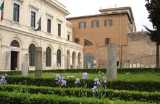
National Museum of Rome
Encyclopedia

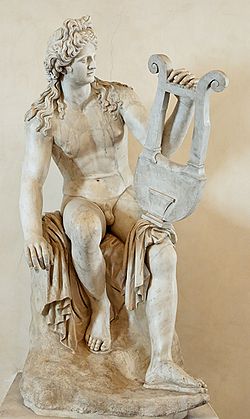
Rome
Rome is the capital of Italy and the country's largest and most populated city and comune, with over 2.7 million residents in . The city is located in the central-western portion of the Italian Peninsula, on the Tiber River within the Lazio region of Italy.Rome's history spans two and a half...
, Italy
Italy
Italy , officially the Italian Republic languages]] under the European Charter for Regional or Minority Languages. In each of these, Italy's official name is as follows:;;;;;;;;), is a unitary parliamentary republic in South-Central Europe. To the north it borders France, Switzerland, Austria and...
, split among various branches across the city. It was founded in 1889 and inaugurated in 1890, with the aim of collecting antiquities from between the 5th century BC to the 3rd century AD.
Its first collection was formed from the archeological collections of the Museo Kircheriano, a collection assembled by the antiquarian
Antiquarian
An antiquarian or antiquary is an aficionado or student of antiquities or things of the past. More specifically, the term is used for those who study history with particular attention to ancient objects of art or science, archaeological and historic sites, or historic archives and manuscripts...
Athanasius Kircher
Athanasius Kircher
Athanasius Kircher was a 17th century German Jesuit scholar who published around 40 works, most notably in the fields of oriental studies, geology, and medicine...
, soon supplemented by the numerous new discoveries in Rome that took place during the expansive city planning effort after it became the capital of the new Kingdom of Italy. This was initially meant to be displayed in a 'Museo Tiberino' (never realised), but in 1901 the State granted the institution the Villa Ludovisi
Villa Ludovisi
The Villa Ludovisi was a suburban villa in Rome, built in the 17th century on the area once occupied by the Gardens of Sallust near the Porta Salaria...
and the important national collection of ancient sculptures.
Its base was established in the 16th century cloister
Cloister
A cloister is a rectangular open space surrounded by covered walks or open galleries, with open arcades on the inner side, running along the walls of buildings and forming a quadrangle or garth...
built by Michelangelo
Michelangelo
Michelangelo di Lodovico Buonarroti Simoni , commonly known as Michelangelo, was an Italian Renaissance painter, sculptor, architect, poet, and engineer who exerted an unparalleled influence on the development of Western art...
off the baths of Diocletian
Baths of Diocletian
The Baths of Diocletian in Rome were the grandest of the public baths, or thermae built by successive emperors. Diocletian's Baths, dedicated in 306, were the largest and most sumptuous of the imperial baths. The baths were built between the years 298 AD and 306 AD...
, still its main base. These buildings' adaptation to their new purpose began for the 1911 Exposition; this effort was completed in the 1930s.
History of the building
In 1981, digging on a derelict city-centre site in the Campus MartiusCampus Martius
The Campus Martius , was a publicly owned area of ancient Rome about in extent. In the Middle Ages, it was the most populous area of Rome...
between the churches of Santa Caterina dei Funari
Santa Caterina dei Funari
Santa Caterina dei Funari is a church in Rome in Italy, in the rione of Sant'Angelo. The church is mainly known for its façade and its interior with frescoes and paintings.-History:...
and San Stanislao dei Polacchi, Daniel Manacorda and his team discovered the colonnaded quadriporticus of the Theatre of Lucius Cornelius Balbus
Lucius Cornelius Balbus (minor)
Lucius Cornelius Balbus , received Roman citizenship at the same time as his uncle....
, the nearby statio annonae
Grain supply to the city of Rome
In classical antiquity, the grain supply to the city of Rome could not be met entirely from the surrounding countryside, which was taken up by the villas and parks of the aristocracy and which produced mainly fruit, vegetables and other perishable goods...
and evidence of later, medieval occupation of the site. These are presented in this branch, inaugurated in 2001, which houses the archaeological remains and finds from that dig (including a stucco
Stucco
Stucco or render is a material made of an aggregate, a binder, and water. Stucco is applied wet and hardens to a very dense solid. It is used as decorative coating for walls and ceilings and as a sculptural and artistic material in architecture...
arch from the porticus). The Crypta Balbi is located at Via Delle Botteghe Oscure 31 at the corner of Via M. Caetani.
Collections
As well as new material from the excavations, objects in this museum come from- the collections of the former Kircherian Museum
- the Gorga and Betti collections
- numismatic material from the Gnecchi collections and the collection of Victor Emmanuel III of Savoy,
- collections from the Roman ForumRoman ForumThe Roman Forum is a rectangular forum surrounded by the ruins of several important ancient government buildings at the center of the city of Rome. Citizens of the ancient city referred to this space, originally a marketplace, as the Forum Magnum, or simply the Forum...
, in particular a fresco and marble architraveArchitraveAn architrave is the lintel or beam that rests on the capitals of the columns. It is an architectural element in Classical architecture.-Classical architecture:...
from the late-1930s Fascist deconstruction of the medieval church of Sant'Adriano in the Curia senatus. - Museum of the Palazzo VeneziaPalazzo VeneziaThe Palazzo di Venezia is a palazzo in central Rome, Italy, just north of the Capitoline Hill. The original structure of this great architectural complex consisted of a modest medieval house intended as the residence of the cardinals appointed to the Church of San Marco...
- the Capitoline MuseumsCapitoline MuseumsThe Capitoline Museums are a group of art and archeological museums in Piazza del Campidoglio, on top of the Capitoline Hill in Rome, Italy. The museums are contained in three palazzi surrounding a central trapezoidal piazza in a plan conceived by Michelangelo Buonarroti in 1536 and executed over...
- the communal Antiquarium of Rome
- frescoes removed in 1960 from the church of Santa Maria in Via LataSanta Maria in Via LataSanta Maria in Via Lata is a church on the Via del Corso , in Rome, Italy.-History:It is claimed that St. Paul spent two years here, in the crypt under the church, whilst under house arrest waiting for his trial. This conflicts with the tradition regarding San Paolo alla Regola...
Basement
The building's basement contains archaeological remains; to see them, the visitor must be guided by a member of museum staff.Ground floor
The first section ("Archaeology and history of an urban landscape") presents the results of the excavations, and puts them in the context of the history of the area. As well as the remains from the site itself, this section also tells of the Monastero di Santa Maria Domine Rose (begun nearby in the 8th century), of medieval merchants' and craftsmen's homes, of the Conservatorio di Santa Caterina dei Funari (built in the mid-16th century by Ignatius of LoyolaIgnatius of Loyola
Ignatius of Loyola was a Spanish knight from a Basque noble family, hermit, priest since 1537, and theologian, who founded the Society of Jesus and was its first Superior General. Ignatius emerged as a religious leader during the Counter-Reformation...
to house the daughters of Roman prostitutes) and of the Botteghe Obscura.
First floor
A second section ("Rome from Antiquity to the Middle Ages") is the Museum of Medieval Rome and illustrates the life and transformation of Rome as a whole between the 5th and 10th centuries AD.History of the Area
The Palazzo Altemps is located in the modern rione PontePonte
Ponte, a word meaning bridge in Italian, Portuguese and Galician languages, may refer to:-Italy:Municipalities*Ponte , in the Province of Benevento*Ponte Buggianese, in the Province of Pistoia*Ponte dell'Olio, in the Province of Piacenza...
, part of the Campus Martius
Campus Martius
The Campus Martius , was a publicly owned area of ancient Rome about in extent. In the Middle Ages, it was the most populous area of Rome...
, a part of Ancient Rome that was developed beginning under the emperor Augustus
Augustus
Augustus ;23 September 63 BC – 19 August AD 14) is considered the first emperor of the Roman Empire, which he ruled alone from 27 BC until his death in 14 AD.The dates of his rule are contemporary dates; Augustus lived under two calendars, the Roman Republican until 45 BC, and the Julian...
. It is located directly north of the Piazza Navona
Piazza Navona
Piazza Navona is a city square in Rome, Italy. It is built on the site of the Stadium of Domitian, built in 1st century AD, and follows the form of the open space of the stadium. The ancient Romans came there to watch the agones , and hence it was known as 'Circus Agonalis'...
. In the ancient period, this site was only 160 meters from the Ponte Elio, and was one of the two main marble ports on the Tiber River in Rome. The other was located in what is now Testaccio
Testaccio
Testaccio is the 20th rione of Rome, deriving its name from Monte Testaccio. In antiquity, much of the Tiber River trade took place here, and the remains of broken clay vessels were stacked creating the artificial Testaccio hill, which today is a source of much archeological evidence as to the...
. In 1891, during the construction works to build the embankments that now hold back the Tiber River, the remains of this dock were uncovered. The marble was worked--into statuary, sculptural decoration, or architectural decoration--in shops, the ruins of which have been found in the zone between the church of Sant'Andrea della Valle, the Chiesa Nuova, and the Tiber River. A few of these ancient shops bear signs of hasty abandonment after the time of the emperor Trajan
Trajan
Trajan , was Roman Emperor from 98 to 117 AD. Born into a non-patrician family in the province of Hispania Baetica, in Spain Trajan rose to prominence during the reign of emperor Domitian. Serving as a legatus legionis in Hispania Tarraconensis, in Spain, in 89 Trajan supported the emperor against...
; tools and even unfinished statues were discovered in some cases.
There was also likely a temple to Apollo located in this area, over which has been built the church of Sant'Apollinare
Sant'Apollinare alle Terme Neroniane-Alessandrine
Sant'Apollinare alle Terme is a titular church in Rome, Italy, dedicated to Apollinare, the first bishop of Ravenna. It is the station church for Thursday fifth week in Lent.-History:...
.
In the Middle Ages
Middle Ages
The Middle Ages is a periodization of European history from the 5th century to the 15th century. The Middle Ages follows the fall of the Western Roman Empire in 476 and precedes the Early Modern Era. It is the middle period of a three-period division of Western history: Classic, Medieval and Modern...
and onwards, the Campus Martius
Campus Martius
The Campus Martius , was a publicly owned area of ancient Rome about in extent. In the Middle Ages, it was the most populous area of Rome...
was divided by the noble families of Rome. The east was controlled by the Ghibellines, led by the Colonna family, and the west by the Guelfs, led by the Orsini family. The division was mostly abandoned after the Great Schism
Western Schism
The Western Schism or Papal Schism was a split within the Catholic Church from 1378 to 1417. Two men simultaneously claimed to be the true pope. Driven by politics rather than any theological disagreement, the schism was ended by the Council of Constance . The simultaneous claims to the papal chair...
in the 15th century, and the Campus Martius underwent a period of urbanization, leading to the Palazzo Altemps now visible.
History of the building
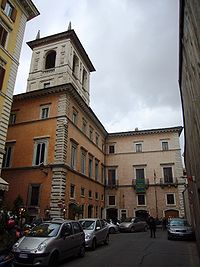
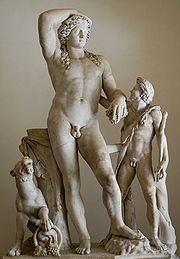


The building was designed in the 15th century by Melozzo da Forlì
Melozzo da Forlì
Melozzo da Forlì was an Italian Renaissance painter and architect. His fresco paintings are notable for the use of foreshortening. He was the most important member of the Forlì painting school.- Biography :...
for Girolamo Riario
Girolamo Riario
Girolamo Riario was Lord of Imola and Forlì in the 15th century.- Biography :Born in Savona, Riario was the son of Paolo Riario and Bianca della Rovere...
, who was related to Pope Sixtus IV
Pope Sixtus IV
Pope Sixtus IV , born Francesco della Rovere, was Pope from 1471 to 1484. His accomplishments as Pope included the establishment of the Sistine Chapel; the group of artists that he brought together introduced the Early Renaissance into Rome with the first masterpiece of the city's new artistic age,...
. There is still a fresco on one wall of the Room of the Sideboard in the Palazzo that celebrates the wedding of Girolamo to Caterina Sforza
Caterina Sforza
Caterina Sforza, Countess of Forlì was an Italian noblewoman, the illegitimate daughter of Galeazzo Maria Sforza, Duke of Milan and Lucrezia Landriani, the wife of the courtier Gian Piero Landriani, a close friend of the Duke...
in 1477, showing the silver plates and other wedding gifts given to the couple. When the Riario family began to decline after the death of Sixtus IV, the Palazzo was sold to Cardinal Francesco Soderini of Volterra, who commissioned further refinements from the architects Antonio da Sangallo the Elder
Antonio da Sangallo the Elder
Antonio da Sangallo the Elder was an Italian Renaissance architect who specialized in the design of fortifications.-Biography:Antonio da Sangallo was born at Florence....
and Baldassarre Peruzzi. When his own family fell on hard times, he in turn sold it in 1568 to the Austrian-born cardinal Marco Sittico Altemps
Markus Sitticus von Hohenems Altemps
Markus Sitticus III von Hohenems Altemps, Cardinal Altemps was a German Catholic prelate, who was Bishop of Constance , papal legate and Cardinal.-Biography:...
, the son of the sister of Pope Pius IV
Pope Pius IV
Pope Pius IV , born Giovanni Angelo Medici, was Pope from 1559 to 1565. He is notable for presiding over the culmination of the Council of Trent.-Biography:...
. Cardinal Altemps commissioned the architect Martino Longhi
Martino Longhi the Elder
Martino Longhi the Elder was an Italian architect, the father of Onorio Longhi and the grandfather of Martino Longhi the Younger.He was born in Viggiù into a family of architects, and initially worked in Germany for the Altemps family, who were relatives of the Milanese Borromeo...
to expand and improve the palazzo; it was Longhi who built the 'belvedere'. He had an impressive collection of books and ancient sculpture that he wished to display. Though his position as the second son in his family meant that Marco Sittico Altemps was destined for the priesthood, he was not inclined to be a cleric, and his mistress bore him a son, Roberto, made duca di Gallese. Unfortunately, Roberto did not enjoy the Palazzo long; he was executed for adultery in 1586 by Pope Sixtus V
Pope Sixtus V
Pope Sixtus V , born Felice Peretti di Montalto, was Pope from 1585 to 1590.-Early life:The chronicler Andrija Zmajević states that Felice's family originated from modern-day Montenegro...
.
The Altemps family continued, though, to mix in the circles of Italian nobility throughout the 17th century. Roberto's granddaughter Maria Cristina d'Altemps married Ippolito Lante Montefeltro della Rovere
Ippolito Lante Montefeltro della Rovere
Ippolito Lante Montefeltro della Rovere was an Italian nobleman and Duke of Bomarzo.-Biography:Lante was the son of Marcantonio Lante and his wife Lucrezia della Rovere. He was nephew to his father's brother, Cardinal Marcello Lante della Rovere...
, Duke of Bomarzo
Bomarzo
Bomarzo is a town and comune of the province of Viterbo , in the lower valley of the Tiber. It is located 14.5 km ENE of Viterbo and 68 km NNW of Rome.-History:...
.
The Palazzo Altemps became the property of the Holy See
Holy See
The Holy See is the episcopal jurisdiction of the Catholic Church in Rome, in which its Bishop is commonly known as the Pope. It is the preeminent episcopal see of the Catholic Church, forming the central government of the Church. As such, diplomatically, and in other spheres the Holy See acts and...
in the 19th century, and the building was used as a seminary for a short time. It was granted to the Italian State in 1982 and after 15 years of restoration, inaugurated as a museum in 1997.
Collections
It houses the museum's displays on the history of collecting (sculptures from Renaissance collections such as the BoncompagniBoncompagni
The Boncompagni is an Italian noble family from Assisi.-History:The family is documented for the first time in 1133, when one Rodolfo Boncompagni, a German nobleman of Saxon origins, was appointed by Lothair II as lord of Assisi...
-Ludovisi
Ludovisi
Ludovisi can refer to:*Ludovisi , a noble Italian family*Ludovisi, Lazio, a rione in the City of Rome* Alberico Boncompagni Ludovisi, prince of Venosa and proprietor of Latium wine estate Fiorano...
and Mattei
Mattei
Mattei can refer to:Places:* Mattei, CaliforniaNoble families:* Mattei , noble Roman family* Marquis Mattei, noble Maltese familyPeople:* Bruno Mattei, Italian movie director...
collections, including the Ludovisi Ares
Ludovisi Ares
The Ludovisi Ares is an Antonine Roman marble sculpture of Mars, a fine 2nd-century copy of a late 4th-century BCE Greek original, associated with Scopas or Lysippus: thus the Roman god of war receives his Greek name, Ares....
and the Suicide of a Gaul
Ludovisi Gaul
The Ludovisi Gaul Killing Himself and His Wife is a Roman marble group depicting a man in the act of plunging a sword into his breast, looking backwards defiantly while he supports the dying figure of a woman with his left arm...
(from the same Pergamon
Pergamon
Pergamon , or Pergamum, was an ancient Greek city in modern-day Turkey, in Mysia, today located from the Aegean Sea on a promontory on the north side of the river Caicus , that became the capital of the Kingdom of Pergamon during the Hellenistic period, under the Attalid dynasty, 281–133 BC...
group as the Dying Gaul
Dying Gaul
The Dying Gaul , formerly known as the Dying Gladiator, is an ancient Roman marble copy of a lost Hellenistic sculpture that is thought to have been executed in bronze, which was commissioned some time between 230 BC and 220 BC by Attalus I of Pergamon to celebrate his victory over the Celtic...
) and the 'Egyptian Collection (sculptures of eastern deities). The palace also includes the historic private theatre, at present used to house temporary exhibitions, and the church of Sant' Aniceto.
Palazzo Massimo alle Terme

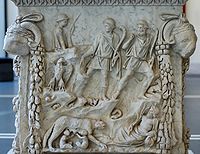
History of the building
On the site of Pope Sixtus VPope Sixtus V
Pope Sixtus V , born Felice Peretti di Montalto, was Pope from 1585 to 1590.-Early life:The chronicler Andrija Zmajević states that Felice's family originated from modern-day Montenegro...
's Villa Montalto-Peretti (demolished in 1883 after the construction of the nearby train station), the present building was constructed in the neo-cinquecentesco style between 1883 and 1887 by the architect Camillo Pistrucci to house a Jesuit seminary. Used partially as a military hospital during the second world war, it then returned to scholastic functions until 1960. In 1981, by which time it was crumbling, the State acquired it for 19 billion lire and granted it to the museum. Its restoration and adaptation began in 1983. It was inaugurated as part of the museum in 1995 and completed in 1998.
Collections
It accommodates the sculpture (republican, empire and late empire) and coin/jewelry collections.Basement
The Museum's numismatic collections, showing the evolution of currency in Italy. Most of the coins on display in the collections are very rare. It is worth mentioning TheodoricTheodoric the Great
Theodoric the Great was king of the Ostrogoths , ruler of Italy , regent of the Visigoths , and a viceroy of the Eastern Roman Empire...
’s medallion, the four ducats of Pope Paul II
Pope Paul II
Pope Paul II , born Pietro Barbo, was pope from 1464 until his death in 1471.- Early life :He was born in Venice, and was a nephew of Pope Eugene IV , through his mother. His adoption of the spiritual career, after having been trained as a merchant, was prompted by his uncle's election as pope...
with the navicella
Navicella
Navicella is a genus of fungi in the family Massariaceae. "Navicella" is Italian for "small ship", and also found in English in reference to a mosaic by Giotto in St Peter's, Rome, now so often restored as to be effectively lost. In the 19th century the genus of molluscs now called Septaria were...
of St Peter, and the silver piastre
Piastre
The piastre or piaster refers to a number of units of currency. The term originates from the Italian for 'thin metal plate'. The name was applied to Spanish and Latin American pieces of eight, or pesos, by Venetian traders in the Levant in the 16th century.These pesos, minted continually for...
of the Pontifical State with views of the city of Rome
Rome
Rome is the capital of Italy and the country's largest and most populated city and comune, with over 2.7 million residents in . The city is located in the central-western portion of the Italian Peninsula, on the Tiber River within the Lazio region of Italy.Rome's history spans two and a half...
.

Mummy
A mummy is a body, human or animal, whose skin and organs have been preserved by either intentional or incidental exposure to chemicals, extreme coldness , very low humidity, or lack of air when bodies are submerged in bogs, so that the recovered body will not decay further if kept in cool and dry...
that was found in 1964 on the Via Cassia
Via Cassia
The Via Cassia was an important Roman road striking out of the Via Flaminia near the Milvian Bridge in the immediate vicinity of Rome and, passing not far from Veii traversed Etruria...
, inside a richly decorated sarcophagus
Sarcophagus
A sarcophagus is a funeral receptacle for a corpse, most commonly carved or cut from stone. The word "sarcophagus" comes from the Greek σαρξ sarx meaning "flesh", and φαγειν phagein meaning "to eat", hence sarkophagus means "flesh-eating"; from the phrase lithos sarkophagos...
with several artefacts
Artifact (archaeology)
An artifact or artefact is "something made or given shape by man, such as a tool or a work of art, esp an object of archaeological interest"...
in amber
Amber
Amber is fossilized tree resin , which has been appreciated for its color and natural beauty since Neolithic times. Amber is used as an ingredient in perfumes, as a healing agent in folk medicine, and as jewelry. There are five classes of amber, defined on the basis of their chemical constituents...
and pieces of jewellery
Jewellery
Jewellery or jewelry is a form of personal adornment, such as brooches, rings, necklaces, earrings, and bracelets.With some exceptions, such as medical alert bracelets or military dog tags, jewellery normally differs from other items of personal adornment in that it has no other purpose than to...
also on display.
Ground floor and first floor
Sculptures of the period between the late Roman RepublicRoman Republic
The Roman Republic was the period of the ancient Roman civilization where the government operated as a republic. It began with the overthrow of the Roman monarchy, traditionally dated around 508 BC, and its replacement by a government headed by two consuls, elected annually by the citizens and...
and the early imperial period
Roman Empire
The Roman Empire was the post-Republican period of the ancient Roman civilization, characterised by an autocratic form of government and large territorial holdings in Europe and around the Mediterranean....
(2nd century BC to 1st century AD), including the famous Tivoli General and Via Labicana Augustus
Via Labicana Augustus
The Via Labicana Augustus is a sculpture of the Roman emperor Augustus as Pontifex Maximus, with his head veiled for a sacrifice. The statue is dated as having been made after 12 BC. It was found on slopes of Oppian Hill, in the Via Labicana, in 1910...
(the latter from Livia
Livia
Livia Drusilla, , after her formal adoption into the Julian family in AD 14 also known as Julia Augusta, was a Roman empress as the third wife of the Emperor Augustus and his adviser...
's villa on the Via Labicana
Via Labicana
The Via Labicana was an ancient road of Italy, leading east southeast from Rome. It seems possible that the road at first led to Tusculum, that it was then extended to Labici, and later still became a road for through traffic; it may even have superseded the Via Latina as a route to the southeast,...
). Themes explored are Hellenistic influences on Roman art, and the development of the portraiture of the emperors.
Second floor
Frescoes, stucci and mosaics, including those from the villa of LiviaVilla of Livia
The villa of Livia was probably part of Livia Drusilla's dowry brought to the Julio-Claudian dynasty. It was named and famous for its breed of white chickens and for its laurel grove , which were given auspiciously omened origins by Suetonius...
, wife of Augustus
Augustus
Augustus ;23 September 63 BC – 19 August AD 14) is considered the first emperor of the Roman Empire, which he ruled alone from 27 BC until his death in 14 AD.The dates of his rule are contemporary dates; Augustus lived under two calendars, the Roman Republican until 45 BC, and the Julian...
, at Prima Porta
Prima Porta
Prima Porta is a suburb of Rome located 12 kilometres north of its center along the Via Flaminia and just a kilometre outside of the Grande Raccordo Anulare highway. It is located on the right bank of the Tiber where the Via Tiberina leads away from the Via Flaminia and another road led off along...
on the Via Flaminia
Via Flaminia
The Via Flaminia was an ancient Roman road leading from Rome over the Apennine Mountains to Ariminum on the coast of the Adriatic Sea, and due to the ruggedness of the mountains was the major option the Romans had for travel between Etruria, Latium and Campania and the Po Valley...
. It begins with the summer triclinium
Triclinium
A triclinium is a formal dining room in a Roman building. The word is adopted from the Greek τρικλίνιον, triklinion, from τρι-, tri-, "three", and κλίνη, klinē, a sort of "couch" or rather chaise longue...
of Livia's Villa “ad Gallinas Albas”. The frescoes, discovered in 1863 and dating back to the 1st century BC, show a luscious garden with ornamental plants and pomegranate
Pomegranate
The pomegranate , Punica granatum, is a fruit-bearing deciduous shrub or small tree growing between five and eight meters tall.Native to the area of modern day Iran, the pomegranate has been cultivated in the Caucasus since ancient times. From there it spread to Asian areas such as the Caucasus as...
trees. Each plant and bird species is very lifelike.
Cloister of Michelangelo
Within it, a 16th-century garden and outdoor displays of altars and funerary sculpture and inscriptions.Main hall of the baths
Still preserved, and used mainly for temporary exhibitions whilst a permanent exhibition of finds from some important urban excavations is in preparation.Octagonal Aula
Restored in 1991. Devoted to sculptures found on baths sites in Rome, including the bronze Athlete and BoxerBoxer of Quirinal
The bronze Boxer of Quirinal, also known as the Terme Boxer, is a Hellenistic Greek sculpture dated around 330 B.C. of a sitting boxer with Caestus, a type of leather hand-wrap known as in the collection of the National Museum of Rome...
(now on display at the Palazzo Massimo alle Terme site) from the Baths of Constantine
Baths of Constantine (Rome)
Baths of Constantine was a public bathing complex built on the Quirinal Hill in Rome by Constantine I, probably before 315.-Construction and plan:...
.
See also
- Collections of the National Museum of Rome

